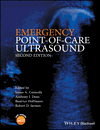Chest Pain and Dyspnea
Summary
Chest pain and dyspnoea are among the most common complaints seen in the emergency department, accounting for nearly 20% of all visits. This chapter focuses on acute coronary syndrome, non-ischaemia-related chest pain, and congestive heart failure (CHF). In addition to ischemic heart disease, causes of chest pain may include pulmonary embolus, disorders of the pericardium, pleura and the chest wall, as well as oesophageal and spinal. A combination of focused cardiac and lung ultrasound can elucidate multiple causes of chest pain. Focused cardiac ultrasound (FoCUS) is useful in evaluating a variety of pathological conditions affecting the pericardium, especially pericardial effusion. In addition to heart failure, a number of disorders can cause dyspnoea, including chronic obstructive pulmonary disease (COPD), asthma, pneumonia, sepsis, pulmonary embolism, deconditioning, metabolic acidosis, anxiety and many others. Pulmonary function tests (PFTs) have been used for many years for distinguishing dyspnoea of pulmonary origin from that of cardiac origin.



